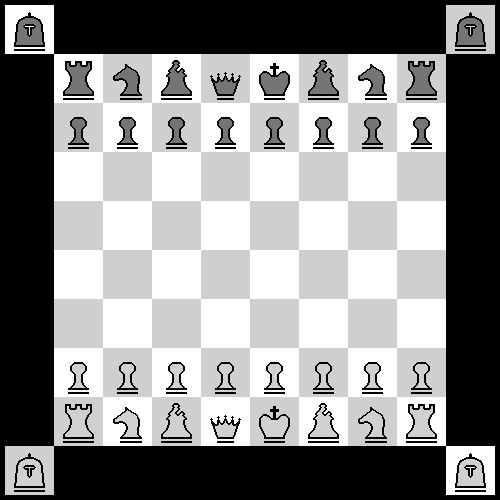Mini Citadel Chess
Just barely big enough to be considered a large chess variant
Introduction
This chess variant was inspired by a variant of Shantranj called Citadel Chess, or Shatranj al-husun. It features a new piece called the Guard, which is very weak. In fact, most of the other pieces are much weaker than their orthodox chess counterparts. But all pieces can also be promoted, all pieces have a special first move, and there are now two ways to win the game. There is a Zillions of Games rules file available for anyone who would like to play this game.
Setup of the Board
This game is played on an 8x8 board with four extra squares at the corners. These extra squares are called citadels and are occupied by Guards at the start of the game.

White: Guard (G) a1, j1; Rook (R) b2, i2; Knight (N) c2, h2; Bishop (B) d2, g2; Queen (Q) e2; King (K) f2; Pawn (P) b3 - i3;
Black: Guard (G) a10, j10; Rook (R) b9, i9; Knight (N) c9, h9; Bishop (B) d9, g9; Queen (Q) e9; King (K) f9; Pawn (P) b8 - i8;
Rules of the Game
All rules of orthodox chess apply unless otherwise stated. The game is won by either checkmating the enemy king, or by occupying one of the enemy citadels. No piece can make a capturing move while entering or leaving a citadel square. All pieces, even the King, are promoted upon reaching the last rank. Promoted pieces gain the ability to move and capture like an orthodox King. All pieces can make a special non-capturing move on their first move.
Movement of the Pieces
Pawn: A Pawn moves and captures like an orthodox Pawn, except that it promotes differently. If a Pawn reaches the far rank it promotes. Once promoted, a Pawn is able to move like an orthodox King. A promoted Pawn loses the ability to capture En Passant, however.
Knight: A Knight moves the same as an orthodox Knight, except that it promotes differently and has a special first move. It may make a non-capturing Guard move when making its first move. Once promoted on the last row, it moves like a Knight and like an orthodox King.
Guard: A Guard moves exactly 2 squares orthogonally or diagonally. It hops over any pieces on the way. It may make a non-capturing Knight move when making its first move. Once promoted on the last row, it may also move as an orthodox King does.
Bishop: A Bishop may leap up to 2 squares away along a diagonal. It may make a non-capturing Knight move when making its first move. Once promoted on the last row, it may also move one square horizontally or vertically.
Rook: A Rook may leap up to 2 squares orthogonally on a rank or a file. It may make a non-capturing Knight move when making its first move. Once promoted on the last row, it may also move one square diagonally.
Queen: A Queen can move or capture one square diagonally, or capture one square orthogonally. It may make a non-capturing Guard move on its first move. Once promoted on the last row, it may also move one square orthogonally.
King: A King moves or captures one square orthoganally, or captures diagonally. It must end its turn in a safe square. It may make a non-capturing Guard move on its first move, even to move out of check. The king cannot castle in this game, however.
Additional Notes
I tried to create a delicate balance between two different goals. You can win the game by moving any one of your pieces across the board into a citadel, but you can still win the game by checkmating the enemy King. Checkmate is still a very realistic possibility, with such a weak King and with pieces sometimes used to defend the citadels instead of protecting the King. I also decided to limit the orthodox sliding pieces to make getting into the citadels more of a challenge.
Pieces are not allowed to capture while entering or leaving a citadel. This makes it possible to trap a piece in its own citadel, or to guard a citadel from enemy attack. It is important to note that the Kings restricted movement makes hiding in its own citadels impossible unless promoted first. It is also important to note that Rooks and Pawns can move diagonally after promotion, allowing every piece to potentially gain access to the enemy citadel squares.
Although there is no castling, every piece can make a special first move. Pawns have their double step, and all other pieces can either make a non-capturing Guard or Knight move. This helps to speed up development of pieces and also allows for some defensive moves. Bishops and Guards, both normally bound to their starting color, can switch to a different colored square on their first move. On its first move, the King can leap out of check up to two squares away if necessary.
Written by A.J. Winkelspecht. HTML conversion by David Howe.
This variant is an entry in the 1999 Large Variant contest.
WWW page created: April 16, 1999. Last modified: May 8, 1999.